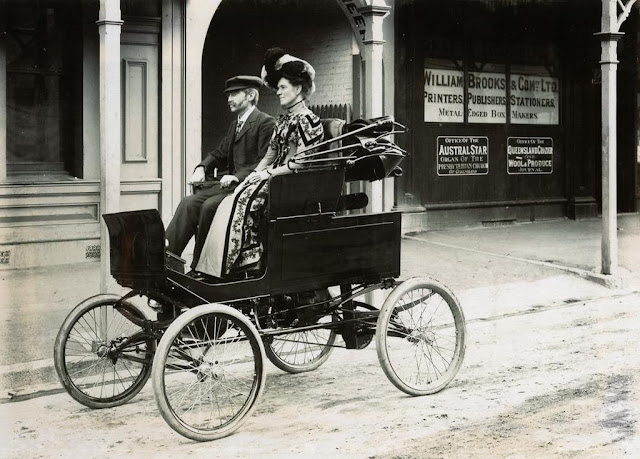Does your daily commute look like this? If it does, I'll bet that you wish you could go back to a time when Brisbane's traffic was a lot lighter.
(Photo: couriermail.com.au)
Would you go this far back? Here is Brisbane's first motor car, photographed in Elizabeth St in 1902.
(Photo: SLQ 257640)
While the city would be empty of cars, the early motorist would have had to contend with unpredictable horses, poor roads and a lack of auto mechanics. From a driver's perspective this early vehicle had wheelsthat would not be out of place on a bicycle and a tiller for steering. I doubt that it was safe or comfortable.
The car in this photograph was known as a Locomobile and was actually steam-powered. It is being driven by Mr James Trackson and his wife is the passenger. To say that Trackson was an enthusiast would be no exaggeration - he was also the first in Brisbane to own an internal combustion car; and in 1905 he was one of the founders of the RACQ, Queensland's motoring body.
Trackson built his own motor car which was dubbed "The Trackson". It was based on a two-cylinder De Dion-Bouton car imported from France in 1900, powered by a 5 hp petrol engine and had a reported top speed of 25 km/h.
James Trackson came to Australia from Norwich in England and he was a qualified electrical engineer. He was associated with erecting the first phone exchange in Melbourne and at Ballarat, and also helped lay the Melbourne cable tramways. He came to Queensland in 1895, and after erecting the first telephone exchange in Queensland he established an engineering firm, Trackson Bros.
James Trackson lived at Newmarket at a property called Sedgley Grange, photographed below.
(Photo: SLQ 121716)
The house was demolished in 1991 and the property is now called Sedgley Park, administered by Brisbane City Council. It is the site of the well-known Newmarket Olympic Pool.
Click here for a Google Map.
tff
(Photo: couriermail.com.au)
Would you go this far back? Here is Brisbane's first motor car, photographed in Elizabeth St in 1902.
(Photo: SLQ 257640)
While the city would be empty of cars, the early motorist would have had to contend with unpredictable horses, poor roads and a lack of auto mechanics. From a driver's perspective this early vehicle had wheelsthat would not be out of place on a bicycle and a tiller for steering. I doubt that it was safe or comfortable.
The car in this photograph was known as a Locomobile and was actually steam-powered. It is being driven by Mr James Trackson and his wife is the passenger. To say that Trackson was an enthusiast would be no exaggeration - he was also the first in Brisbane to own an internal combustion car; and in 1905 he was one of the founders of the RACQ, Queensland's motoring body.
Trackson built his own motor car which was dubbed "The Trackson". It was based on a two-cylinder De Dion-Bouton car imported from France in 1900, powered by a 5 hp petrol engine and had a reported top speed of 25 km/h.
James Trackson came to Australia from Norwich in England and he was a qualified electrical engineer. He was associated with erecting the first phone exchange in Melbourne and at Ballarat, and also helped lay the Melbourne cable tramways. He came to Queensland in 1895, and after erecting the first telephone exchange in Queensland he established an engineering firm, Trackson Bros.
James Trackson lived at Newmarket at a property called Sedgley Grange, photographed below.
(Photo: SLQ 121716)
The house was demolished in 1991 and the property is now called Sedgley Park, administered by Brisbane City Council. It is the site of the well-known Newmarket Olympic Pool.
Click here for a Google Map.
tff


